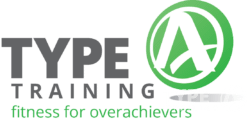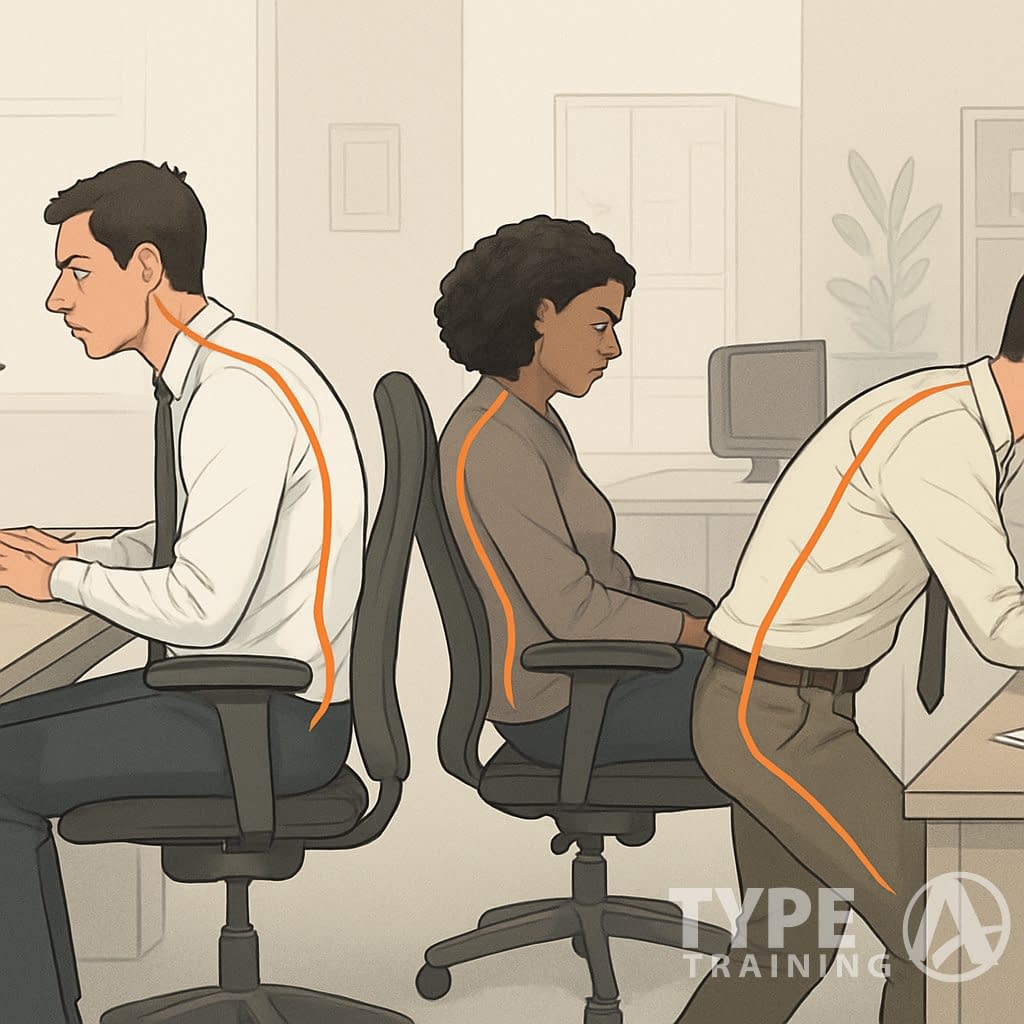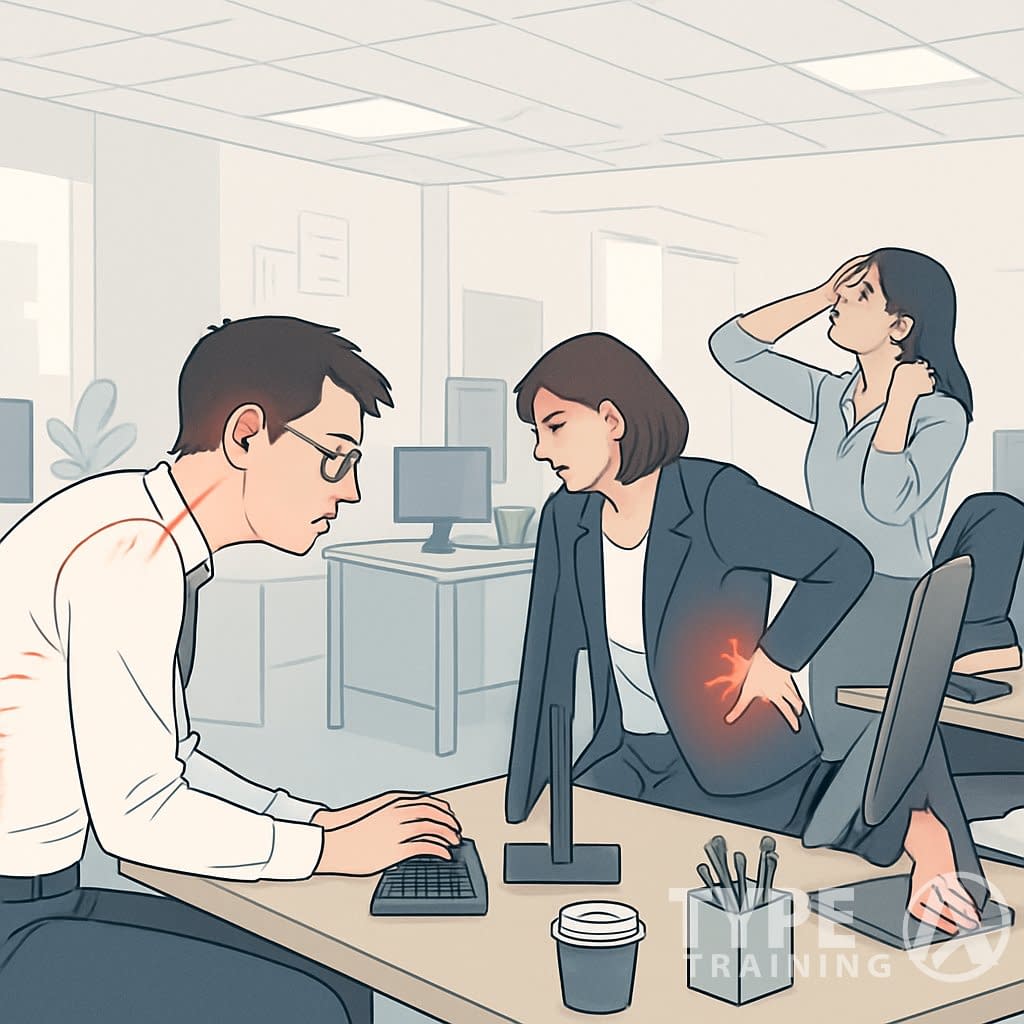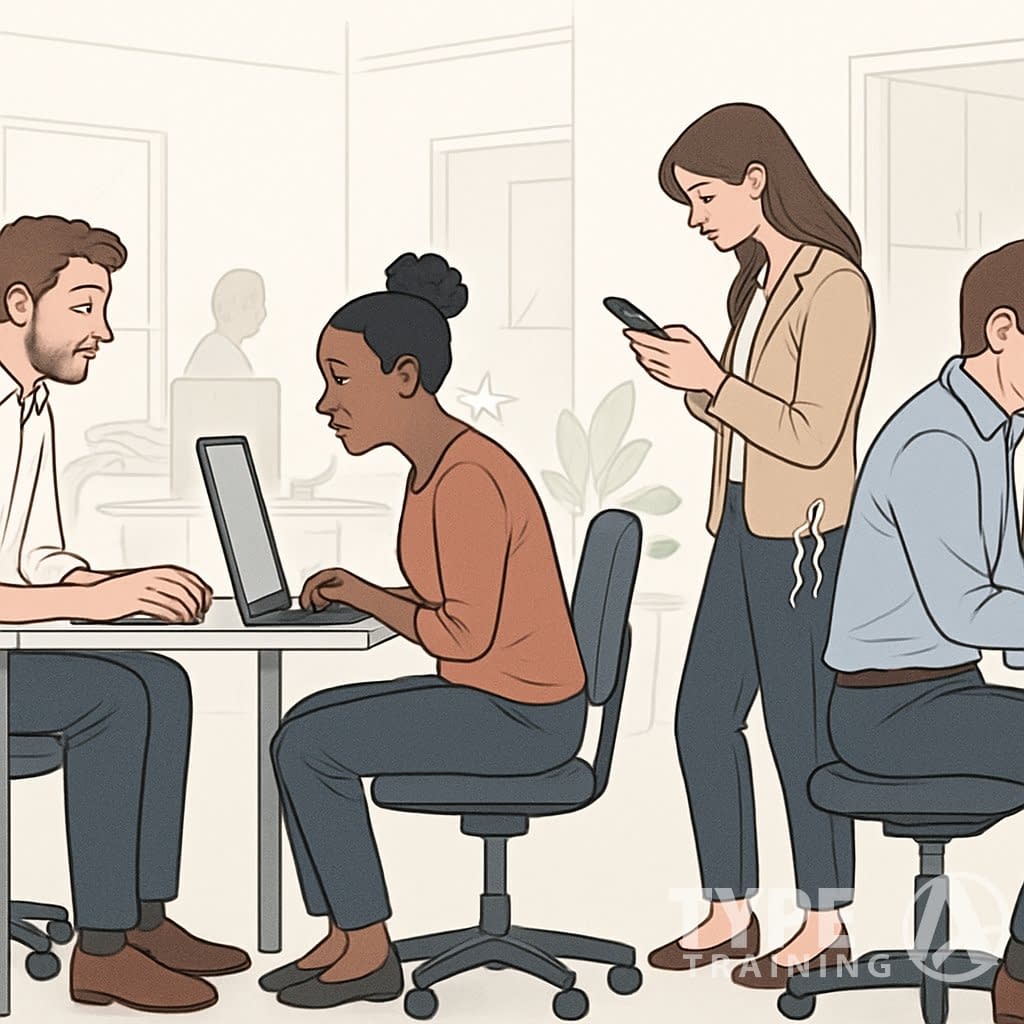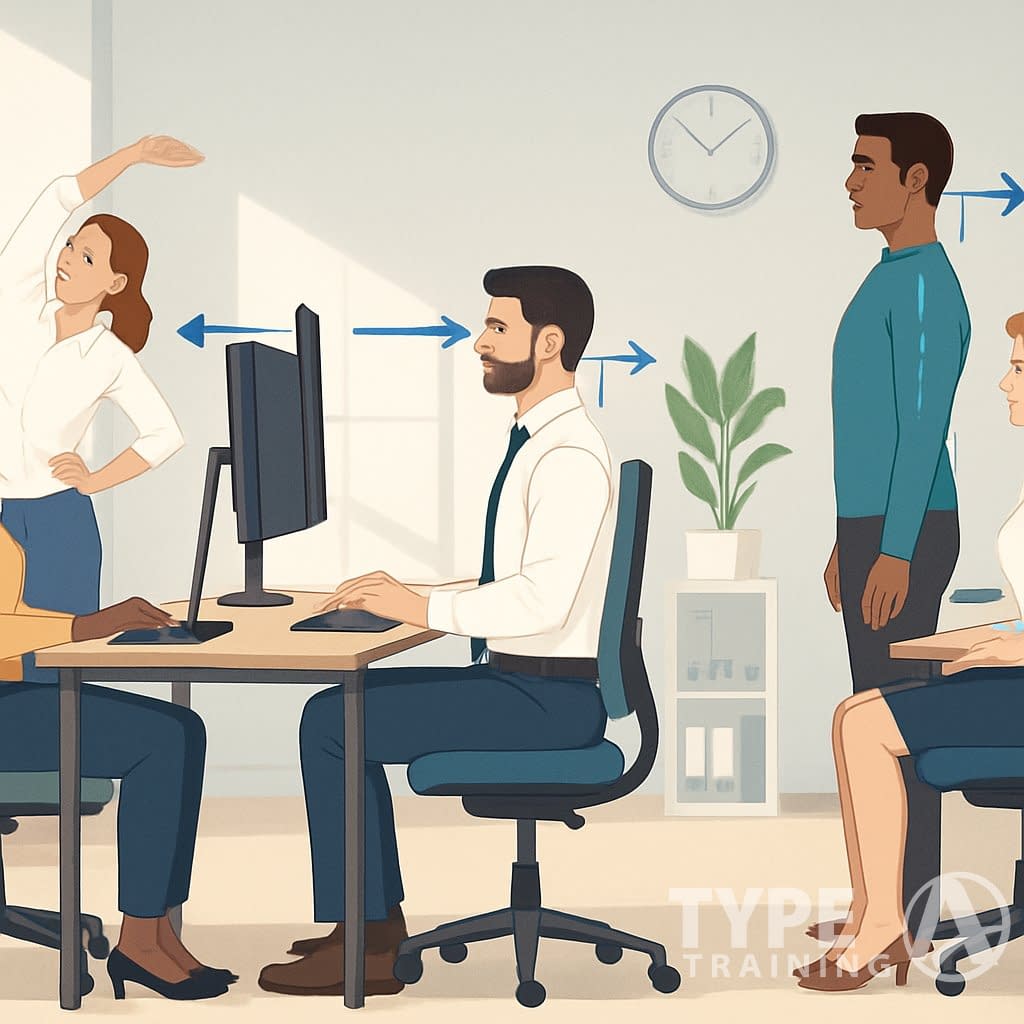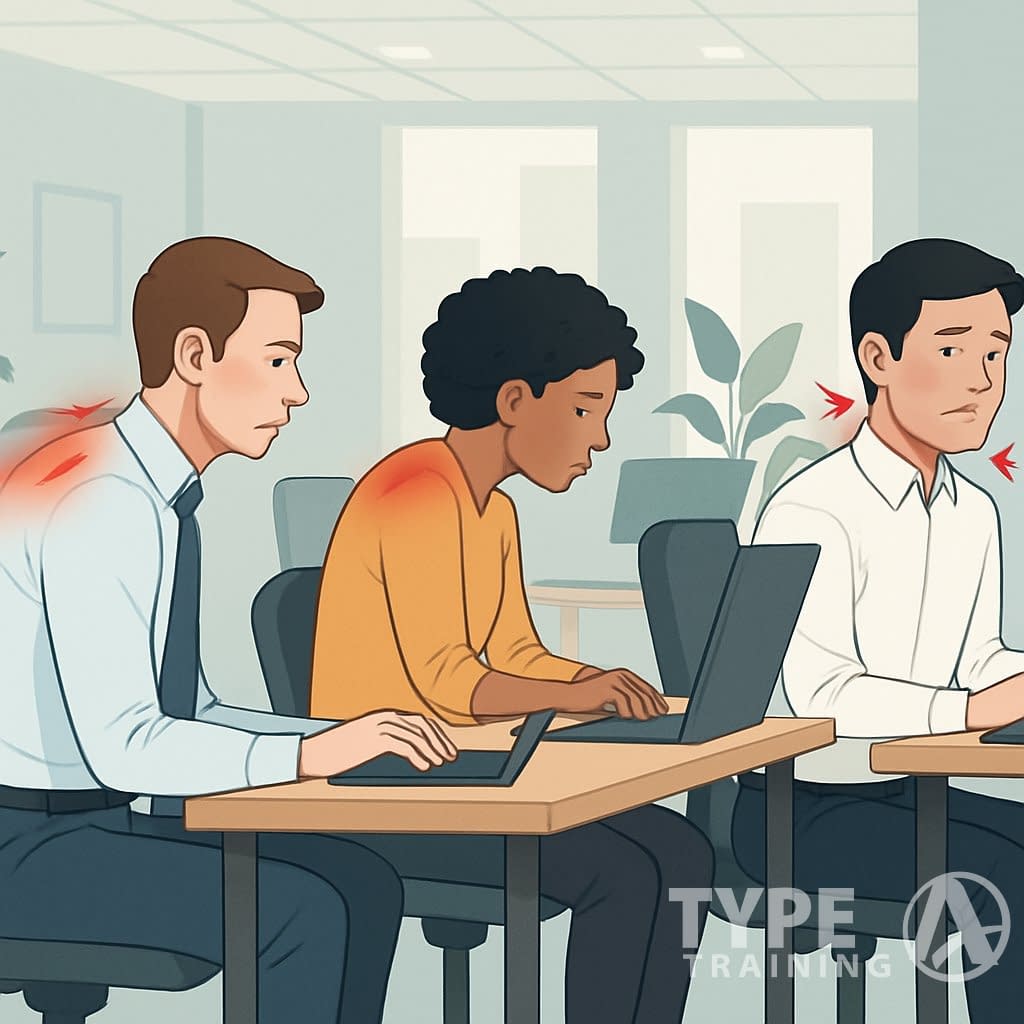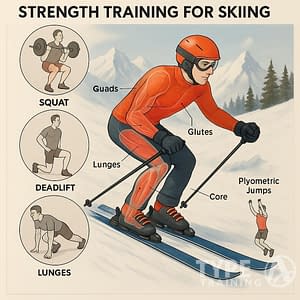You probably don’t realize it, but your daily work habits are slowly changing your body. Hours of sitting at a desk, hunching over your computer, and rushing between meetings create serious posture problems that affect millions of busy professionals.
One of the most common posture problems in busy professionals is poor alignment due to prolonged sitting and lack of movement.
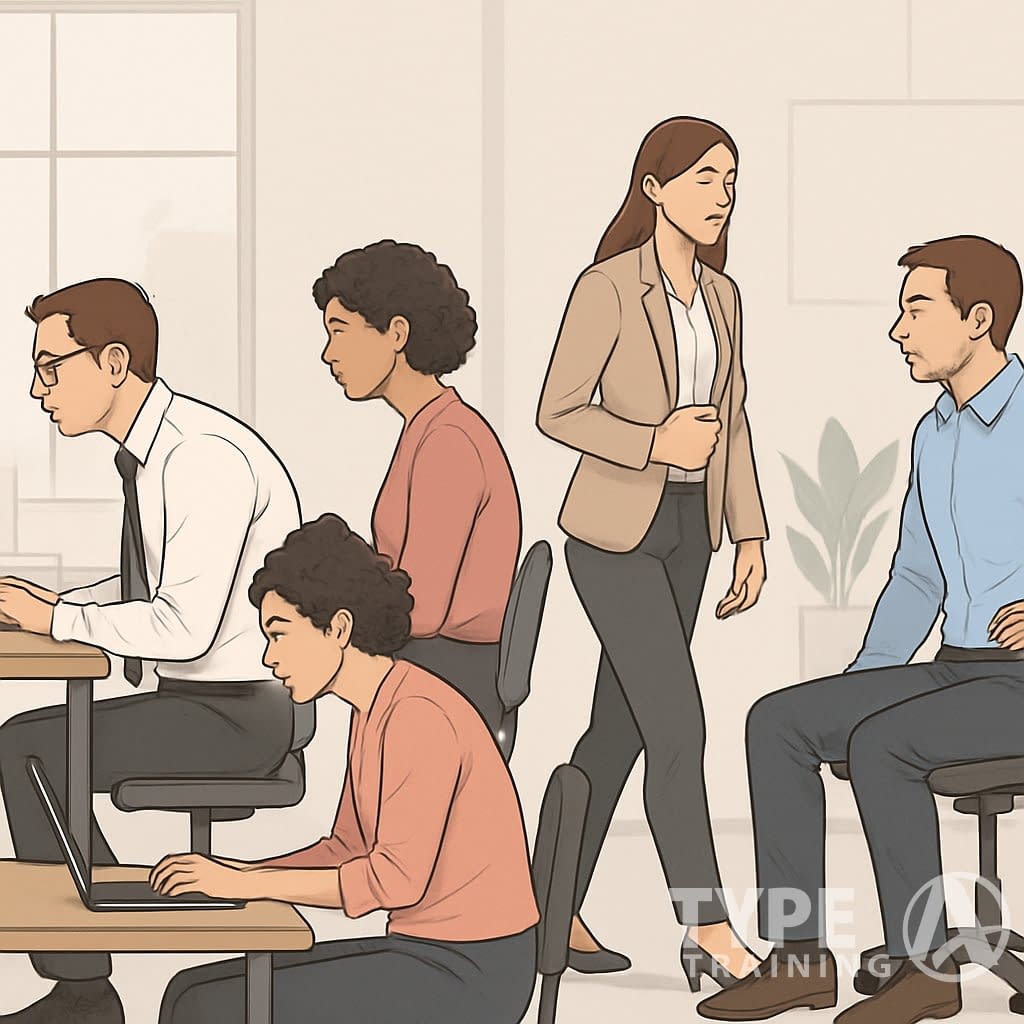
Poor posture from desk work leads to forward head posture, rounded shoulders, and lower back pain that can hurt your health and work performance. These issues don’t happen overnight.
Popular posts:
Understanding common posture problems in busy professionals can help you identify and address these issues early.
They build up slowly as you spend more time in front of screens and less time moving your body.
The good news? You can fix these problems with simple changes to how you sit, stand, and move throughout your workday.
Small adjustments to your workspace and daily habits can make a big difference in how you feel and look.
Key Takeaways
- Sitting for long periods creates muscle imbalances that lead to neck pain, back problems, and reduced energy
- Common workplace posture issues include forward head posture, rounded shoulders, and tight hip muscles from prolonged sitting
- Simple daily exercises, proper desk setup, and regular movement breaks can prevent and reverse most posture problems
Understanding Posture in Professional Life

Posture is really just how your body aligns itself against gravity. Your spine acts as the main support structure that keeps everything in line.
Work activities create challenges that gradually pull your body away from its natural positioning.
Definition of Posture and Its Types
Posture is the way your body positions itself when you sit, stand, or move. It involves the alignment of your head, shoulders, spine, hips, and legs.
Your body maintains two main types of posture throughout the day:
- Static posture – how you hold yourself when not moving
- Dynamic posture – how you position yourself during movement
Good posture keeps your spine in its natural curves. Your ears should sit over your shoulders, and your shoulders should align over your hips.
Poor posture creates imbalances. Your muscles end up working harder just to support your body weight.
Over time, this leads to strain and discomfort.
Most professionals develop static posture problems. Sitting at desks for hours creates the biggest challenges.
Your body adapts to these fixed positions, for better or worse.
Role of the Spine in Maintaining Posture
Your spine has three natural curves that work together. The neck curves slightly forward, the upper back curves backward, and the lower back curves forward again.
These curves act like springs. They absorb shock and distribute weight more evenly.
When the curves stay balanced, your muscles work efficiently. Poor posture flattens or exaggerates these curves, making your spine lose its shock-absorbing ability.
Muscles have to work harder just to keep you upright.
The spine contains 24 moving bones called vertebrae. Discs sit between each bone, cushioning movement and providing flexibility.
When you slouch, extra pressure builds on the front of the discs. This can cause them to bulge backward, leading to pain and stiffness.
How Posture Changes During Work Activities
Work activities create specific posture challenges. Computer work pushes your head forward and rounds your shoulders.
Your upper back can develop a hump-like curve. Typing makes your shoulders roll inward.
Your chest muscles tighten, while upper back muscles weaken. This imbalance is a recipe for aches.
Long meetings make you sink into chairs. Your lower back loses its natural curve, and your hip muscles tighten from all that sitting.
Holding a phone between your ear and shoulder tilts your neck sideways. One side gets tight while the other stretches out.
Standing meetings aren’t always better. You might shift weight to one leg, tilting your pelvis and straining your lower back.
Your body adapts to repeated positions. Muscles that stay shortened get tight, while muscles that stay stretched get weak.
Common Posture Problems in Busy Professionals
Addressing common posture problems in busy professionals requires awareness and proactive measures.
Busy professionals face three main posture problems from long work hours and desk jobs.
Recognizing these common posture problems in busy professionals can lead to better work habits.
Slouching weakens your upper body muscles. Forward head position strains your neck, and poor lower back alignment affects your entire spine.
Slouching and Rounded Shoulders
Slouching happens when you sit or stand with your shoulders rolled forward and your chest caved in. This poor posture easily becomes your default after hours at a computer.
Your chest muscles tighten and shorten in this position. Meanwhile, the muscles between your shoulder blades get weak and stretched out.
Common signs you have this problem:
- Your shoulders sit forward of your ears when viewed from the side
- You feel tension between your shoulder blades
- Your upper back feels stiff and sore
This posture puts extra stress on your upper spine. It can even lead to headaches and make breathing harder since your chest can’t expand fully.
The problem gets worse when you use laptops or look down at your phone a lot. Those activities pull your shoulders even further forward.
Forward Head Posture
Forward head posture is one of the leading common posture problems in busy professionals.
Forward head posture means your head sits in front of your shoulders instead of directly above them. This creates a classic “text neck” look.
Your head weighs about 10-12 pounds. When it moves forward, the weight on your neck muscles jumps dramatically.
Weight increase on neck muscles:
- Normal position: 10-12 pounds
- 1 inch forward: 22 pounds
- 2 inches forward: 32 pounds
- 3 inches forward: 42 pounds
This extra weight makes the muscles at the back of your neck work overtime. They get tight and painful over time.
You might notice your chin jutting forward when you work at a computer. Looking at screens that are too low forces this bad position.
The problem can even mess with your sleep. Tight neck muscles sometimes cause tension headaches or make it tough to get comfortable in bed.
Lower Back Rounding and Pelvic Tilt
Lower back rounding happens when you lose the natural curve in your spine. Your pelvis tilts backward, and your lower back goes flat or curves the wrong way.
Sitting for long periods weakens your core muscles. When these muscles are weak, they can’t support good posture properly.
Your hip flexor muscles also get tight from sitting. These muscles connect your legs to your lower back and pull on your spine when they’re shortened.
Signs of this posture problem:
-
- Lower back pain after sitting
- Tight hamstring muscles
Identifying common posture problems in busy professionals helps you take steps to improve your posture.
- Difficulty standing up straight after sitting
- Hip stiffness when you walk
This position puts pressure on the discs in your lower spine. Over time, this can lead to disc problems and chronic back pain.
The problem gets worse if you use chairs without proper lumbar support. Soft couches and chairs that sink in the middle make this posture issue even more likely.
Consequences of Poor Posture at Work
Poor posture at work creates a chain reaction of physical problems that affect your body from head to toe.
These issues develop gradually but can lead to chronic pain and reduced mobility that impacts your daily life both at work and at home.
Neck Pain and Stiffness
Forward head posture is one of the most common problems you’ll face when working at a computer. This position forces your neck muscles to work overtime to support your head’s weight.
With awareness of common posture problems in busy professionals, you can make small but impactful changes.
Your cervical spine curves naturally to distribute weight evenly. When you crane your neck forward, this curve flattens or reverses.
The muscles at the base of your skull become tight and overworked.
Common symptoms include:
- Tension headaches starting at the back of your head
- Sharp pain when turning your neck
- Muscle knots in your upper trapezius muscles
- Radiating pain into your shoulders
Text neck develops from hours of looking down at screens. For every inch your head moves forward, the effective weight on your neck increases by 10 pounds.
A normal head weighs about 12 pounds, but poor posture can make it feel like 42 pounds to your neck muscles.
Back Pain and Low Back Pain
Slouching while sitting puts enormous pressure on your spine and surrounding muscles. Your lower back bears the brunt of this stress throughout your workday.
When you sit with poor posture, your spine loses its natural S-curve. The discs between your vertebrae compress unevenly.
Many busy professionals experience common posture problems due to their desk-based work environments.
This compression can lead to disc degeneration over time.
Your erector spinae muscles work constantly to keep you upright when you slouch. These muscles fatigue quickly, causing the familiar ache in your middle and lower back.
Poor posture affects your spine in these ways:
Maintaining awareness of common posture problems in busy professionals is crucial for long-term health.
- Increases disc pressure by up to 40%
- Stretches spinal ligaments beyond their normal range
- Creates muscle imbalances between your front and back muscles
- Reduces blood flow to spinal tissues
Low back pain from sitting often worsens throughout the day. You might feel stiff when standing up or experience shooting pains down your legs.
Strategies to combat common posture problems in busy professionals include regular movement and ergonomic adjustments.
Reduced Flexibility and Musculoskeletal Stress
Long hours in poor posture create muscle imbalances that limit your range of motion. Your hip flexors tighten from constant sitting, while your glutes weaken from lack of use.
Your chest muscles shorten and tighten when you hunch forward. Meanwhile, the muscles between your shoulder blades stretch and weaken.
This imbalance pulls your shoulders forward even when you’re not sitting.
Key areas affected by muscle imbalances:
- Hip flexors become tight and shortened
- Hamstrings lose flexibility from prolonged sitting
- Thoracic spine stiffens and loses extension
- Shoulder blades lose stability and strength
These imbalances don’t stay at work. You carry them home, affecting how you move during exercise and daily activities.
Learning about common posture problems in busy professionals can guide you toward better habits.
Simple tasks like reaching overhead or bending down get harder than they should be.
Your body adapts to the positions you spend the most time in. If that’s slouched at a desk, your body will mold itself to that shape over time.
Key Risk Factors Contributing to Postural Problems
Several workplace factors create the perfect conditions for poor posture to develop.
Sitting for long periods, poorly designed workstations, and minimal movement throughout the day all work together to strain your spine and muscles.
Prolonged Sitting and Sedentary Habits
Over 80% of jobs in the United States require mostly sitting. This creates serious problems for your spine and posture.
When you sit for hours, your hip flexors become tight. Your glutes weaken from lack of use.
These changes pull your pelvis out of proper position.
Solutions for common posture problems in busy professionals include taking breaks and adjusting your workspace.
Common effects of prolonged sitting:
- Compressed spinal discs
- Weakened core muscles
- Rounded shoulders
- Forward head position
Your intervertebral discs experience more pressure when sitting than when standing. This pressure jumps even higher when you slouch or lean forward.
Sitting also reduces blood flow to your muscles. Poor circulation makes your muscles stiff and less able to support good posture.
The longer you sit without breaks, the more likely you are to develop chronic back pain. Your body adapts to poor positions when you hold them for extended periods.
Workstation Ergonomics and Setup
Poor ergonomics force your body into unnatural positions. Your workstation setup directly affects how you hold your head, shoulders, and spine.
Many common posture problems in busy professionals stem from poor ergonomics at work.
Critical ergonomic factors:
Awareness of common posture problems in busy professionals can prevent chronic pain.
| Element | Proper Position | Common Problem |
|---|---|---|
| Monitor | Eye level | Too low, causing neck strain |
| Keyboard | Elbow height | Too high or low, straining shoulders |
| Chair | Supports lower back curve | No lumbar support |
| Feet | Flat on floor or footrest | Dangling or cramped |
If your monitor sits too low, you’ll crane your neck downward. This creates “tech neck”—a forward head posture that strains your cervical spine.
A keyboard placed too high forces your shoulders up. Too low makes you round your shoulders forward.
Both positions cause muscle imbalances.
Your chair height affects your entire posture. If it’s too high, your feet dangle and you lose stability.
Adjusting your habits targets common posture problems in busy professionals, leading to better health.
Too low makes you slouch to reach your work surface. A footrest helps when your chair height can’t be adjusted to let your feet rest flat.
It maintains proper knee and hip angles.
Lack of Physical Activity
Physical inactivity weakens the muscles that support good posture. About 25% of Americans get no exercise outside of work.
Your core muscles need regular strengthening to support your spine. Without exercise, these muscles become weak and can’t keep things aligned.
Key muscle groups affected by inactivity:
-
- Core muscles – Support your spine and pelvis
- Upper back muscles – Pull shoulders back and down
- Glutes – Stabilize your pelvis and lower back
- Hip flexors – Need stretching to prevent tightness
Identifying common posture problems in busy professionals can help you stay injury-free.
Regular movement breaks help prevent muscle stiffness. Even short walks or stretches every hour can make a difference.
Exercise improves blood flow to your muscles. Better circulation keeps muscles flexible and strong during your workday.
Strength training helps correct muscle imbalances. It builds the endurance your postural muscles need to support you all day.
Without regular physical activity, your body loses the strength and flexibility needed for good posture. This can spiral into more weakness and stiffness.
Effective Strategies to Improve and Maintain Good Posture
Making specific workplace adjustments, adding regular movement to your day, and developing consistent habits are three main ways to fix posture problems. These strategies work together to reduce strain and help you keep better alignment throughout your workday.
Ergonomic Adjustments in the Workplace
Your desk setup directly affects your spinal alignment. Position your monitor at eye level and arm’s length away to prevent neck strain.
Adjust your chair height so your feet rest flat on the floor. Your thighs should sit parallel to the ground.
Improving your workspace can alleviate common posture problems in busy professionals.
If your feet don’t reach the floor, use a footrest to keep your legs in the right spot. Set your keyboard and mouse at elbow height so your wrists stay straight while typing.
Consider a keyboard tray if your desk sits too high. Replace your regular chair with one that supports the natural curve of your lower back.
Look for adjustable armrests that support your arms without raising your shoulders. Keep frequently used items within arm’s reach to avoid excessive reaching and twisting.
Key ergonomic elements:
- Chair with lumbar support
- Monitor at eye level
- Keyboard at elbow height
- Footrest when needed
- Adequate legroom under desk
Incorporating Regular Movement and Activity
Regular movement is essential to combat common posture problems in busy professionals.
Sitting for hours weakens the muscles that support good posture. Set a timer to remind yourself to stand every 30 minutes.
Take walking breaks during phone calls or meetings if you can. Even two minutes of walking helps counteract the effects of sitting.
Simple desk exercises you can do:
- Shoulder blade squeezes (10 repetitions)
- Neck stretches (hold for 15 seconds each side)
- Seated spinal twists (5 repetitions each direction)
- Ankle circles while seated
Strengthen your core muscles with planks and bridges at home. Strong core muscles provide better support for your spine during long work days.
Try a standing desk for part of your workday. Alternate between sitting and standing every hour to reduce muscle fatigue and boost circulation.
Building Postural Awareness and Habits
Developing habits to address common posture problems in busy professionals is key to maintaining good posture.
Check your posture every hour using phone reminders or computer alerts. Ask yourself if your ears line up over your shoulders and your shoulders over your hips.
Practice the wall test weekly. Stand against a wall with your head, shoulders, and buttocks touching the surface.
This position shows you what good posture feels like. Set up visual cues in your workspace like sticky notes or a small mirror to keep yourself aware.
Daily posture habits:
- Morning posture check in mirror
- Hourly position adjustments
- Evening stretching routine
- Proper lifting techniques
Develop a quick posture reset routine. Pull your shoulders back, lengthen your neck, and engage your core muscles.
Practice this sequence until it becomes automatic. It doesn’t have to be perfect—just consistent.
Simple adjustments can help reduce common posture problems in busy professionals.
Frequently Asked Questions
Poor posture affects up to 79% of young adults. Office workers face specific challenges from desk-based work.
These common concerns address the physical signs, workplace factors, and practical solutions for maintaining better posture throughout your workday.
What are the typical signs of poor posture in office workers?
Forward head posture is one of the most common signs you’ll notice. Your chin sticks out and your neck cranes forward—some folks call this “text neck.”
Rounded shoulders happen when your shoulders roll inward. Let your arms hang naturally; if your knuckles face forward, that’s a sign.
Upper back hunching shows up when you lean over your keyboard or screen. This creates a curved upper spine and tight chest muscles.
Hip imbalances develop if you always lean on one leg while standing. Your weight shifts away from your core and onto your lower back.
You might also notice headaches, neck stiffness, or lower back pain. These symptoms often get worse as the day goes on.
Staying aware of common posture problems in busy professionals can greatly improve your work experience.
How can prolonged desk work contribute to back pain and postural issues?
Sitting for long periods trains your muscles to hold poor positions. Your body adapts to these positions until they feel normal.
Your hip flexors get tight from constant sitting, pulling on your lower back and creating muscle imbalances. Slouching weakens your core muscles, so they can’t support your spine during daily activities.
Poor sitting posture increases strain on your spinal discs. That extra pressure can lead to disc problems and chronic pain over time.
Your upper back muscles stretch and weaken while your chest muscles tighten. This muscle imbalance creates the hunched forward look so common in offices.
What daily exercises can counteract the effects of sitting for extended periods?
Planks strengthen your core muscles that support proper posture. Hold for 30 seconds and try to go longer as you get stronger.
Bridges work your glutes and lower back muscles. These muscles help maintain proper hip alignment when standing.
Chest stretches open tight chest muscles from hunching over your desk. Hold doorway stretches for 30 seconds a few times a day.
Back extensions build your upper back muscles. Do these lying on your stomach or standing against a wall.
Understanding how common posture problems in busy professionals develop can aid in prevention.
Hip flexor stretches loosen tight hip muscles from sitting. Try lunging stretches or standing thigh stretches throughout your day.
Neck stretches help reduce forward head posture. Gently tuck your chin and look up and down slowly.
Are there ergonomic office products that can help improve posture?
Adjustable monitor arms put your screen at eye level. This prevents neck strain from looking up or down at your monitor.
Ergonomic chairs support your lower back’s natural curve. Look for chairs with good lumbar support.
Keyboard trays keep your wrists in a neutral position. This reduces strain on your arms and shoulders while typing.
Standing desks let you switch between sitting and standing. It’s not a cure-all, but it helps break up long sitting sessions.
Footrests help you keep proper leg positioning if your chair is too high. Your feet should rest flat and your knees should bend at 90 degrees.
Document holders put reference materials at eye level. That way, you don’t have to keep looking down at papers.
What role does screen placement play in maintaining good posture?
Employing ergonomic tools can help mitigate common posture problems in busy professionals.
Your monitor should sit at eye level when you look straight ahead. This keeps your neck from straining up or down.
Keep the screen about arm’s length away from your face. If it’s too close or too far, you’ll end up leaning or squinting.
Laptops are tricky since the screen and keyboard are stuck together. Use an external monitor or keyboard to split them up.
If you use multiple monitors, keep them at the same height. Uneven screens make you twist your neck back and forth.
Tablet users should prop devices at a 45-degree angle. Holding tablets flat on your lap just pulls your neck forward—nobody needs that.
How frequently should professionals take breaks to alleviate posture-related strain?
Take a 2-3 minute break every 30 minutes from your desk. Stand up, walk around, and stretch your neck and shoulders.
Change your sitting position every 15-20 minutes. Shift your weight, adjust your chair height, or cross your legs differently.
Perform simple stretches at your desk throughout the day. Shoulder rolls, neck turns, and seated spinal twists don’t even require you to leave your workspace.
Walk for 5-10 minutes every hour if you can swing it. This gets your legs moving and helps loosen up hips that get stiff from sitting.
Taking regular breaks combats common posture problems in busy professionals and promotes well-being.
Set up reminders or use an app to nudge you to move. It’s way too easy to get lost in work and forget about posture breaks.
Try to fit in a longer movement break at lunch or between meetings. Even a 15-20 minute walk can help you reset before the afternoon grind.
